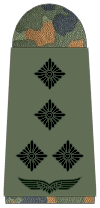Staff captain
Staff captain is the English translation of a number of military ranks:
Historical use of the rank
Czechoslovakia
In the Czechoslovak Army, until 1953, Staff Captain (Czech: štábní kapitán, Slovak: štábny kapitán) was a senior captain rank, ranking between Captain and Major.
Estonia
The rank of staff captain (Estonian: staabikapten) was adopted from the Russian Imperial Army and used briefly by the Estonian military right before the German occupation of Estonia during World War I. During the occupation, it was replaced with the rank of captain.[1]
Ireland
The rank of Staff Captain (Irish: captaen na foirne) was used by the Irish Republican Army during the Irish revolutionary period (1917–23).[2][3]
Prussia
Staff captain (Stabskapitän, also: Stabshauptmann) is a historic military rank used in the Prussian army.
It ranked between the Premierleutnant (later called Oberleutnant) and Hauptmann/Rittmeister in the Prussian army. Its holder represented the actual captain and company commander in his absence, frequently and often for long periods, should his (usually noble) Hauptmann show no interest in leading the company, though the Hauptmann would retain his rank, status and uniform.
In the army of Frederick the Great, a regiment's regimentschef, oberst, staff officers, company commanders and those of nearby rank received a far higher rank than the staff captains who actually led the company. From this difference later developed the salary difference between a first class "Hauptleute first class" and "Hauptleute second class".
Russia

In the Russian Imperial Army (RIA) the OF-2b rank of Stabs-kapitan (Russian: штабс-капитан) counted as a lieutenant captain ("light" captain) or senior lieutenant (ru: старший лейтенант; starshy leytenat) who ranked between poruchik (ru: пору́чик (OF-1a)) and captain (ru: капитан; kapitan (OF-2a)) and was in charge of a company-size military unit.
United Kingdom
In the Royal Navy the master of the fleet was ranked as a "Staff Captain" after 1864, just below the Captain, but he was not considered an executive branch officer and was not eligible for further promotion. Some exceptions were made to this rule, such as transfer to the executive officers list and promotion to Captain of Sir Frederick Evans upon his retirement in 1872, in recognition of his hydrographic survey work and scientific merits.
Current use of the rank
Finland
A rank similar to Stabskapitän, yliluutnantti, is in use in Finnish military ranks.
Germany

Stabshauptmann (StHptm) meaning "Staff Captain", is the highest military rank in the Bundeswehr for specialist officers (Offiziere des Militärfachlichen Dienstes (OffzMilFD)).
Bundeswehr
Instead of being promoted to the rank of major, specialist officers that were holding the rank of Hauptmann (Captain) for a specific time are promoted to the rank of Stabshauptmann and given the salary of a Major. Sometimes regular officers are promoted to a post that is intended for a Stabshauptmann if there is no free post for a Major.
The badge of rank is four silver stars. It is one of the rarest ranks in the German military. The rank has no history outside the Bundeswehr and has been created especially for the MilFD officers. Those are former NCOs who have accomplished a special training programme through which they are given the opportunity to become officers. Their duties are, however, specific, similar to that of a Warrant officer in the English-speaking armies.
| Junior Rank Hauptmann |
German officer rank Stabshauptmann |
Senior Rank Major |
There is no corresponding rank for officers in Bundeswehr Joint Medical Service.
German Navy

The navy equivalent is Stabskapitänleutnant (Staff Lieutenant Captain (Navy)). Its rank insignia are two medium stripes with two narrow stripes between the medium ones.
| Junior Rank Kapitänleutnant |
German Navy officer rank Stabskapitänleutnant |
Senior Rank Korvettenkapitän |
Historical background outside of the Bundeswehr
Historically, a rank named "Stabshauptmann" (also: "Stabskapitän") existed in several German armies (such as Prussia) in the 18th century. However, while the modern Stabshauptman is a Senior Captain senior to a regular Hauptmann, the historical Stabshauptmann was a Junior captain, ranking below Hauptmann rank. In 18th century armies companies often were "owned" by a noble man, who formally was the company's captain, but did not actually command the unit. Instead, the owner of the company appointed an officer from the company his "Stabshauptmann", who technically served as the Hauptmann's mere staff assistant, but actually led the unit in his place.
The reversing in ranking of "Hauptmann" and "Stabshauptmann" in modern times is consequence of the practice in modern German military organisations (Reichswehr, Wehrmacht) to name the highest rank of a rank group beginning with the prefix "Stabs-", indicating that the holder serves in staff position to officers of the next higher rank group, e.g. during World War II, the highest NCO rank in the German army was Stabsfeldwebel, who served as direct assistant to company-grade officers or in staff function. However, this is no longer represented in the Bundeswehr's post-World War II rank structure since the creation of rank levels senior to the "Stabs-" level of ranks, denoted by the prefix "Oberstabs-" ("Senior Staff-", e.g. Oberstabsfeldwebel). There are no plans to create the rank of "Oberstabshauptmann".
International comparison
German pay grade of Stabshauptmann is A13, same as of Major (Hauptmann: A11/A12). According to NATO's STANAG 2116, the NATO rank code of Stabshauptmann is OF-2, same as for regular Hauptmann and therefore equal to Captain rank in other NATO armies. To express the seniority of Stabshauptmann, "OF-2a" or other modifications of the official NATO rank code are in use unofficially.
A similar rank outside the German Bundeswehr is the primo capitano (First Captain) in the Italian military.
See also
- Captain lieutenant — naval rank of junior Captain (naval), equal to the Commonwealth or United States rank of Lieutenant (naval)
- Staff (military)
- History of Russian military ranks
- Captain (disambiguation)
References
- Pajur, Ago (2002). "Kuidas saada kindraliks: ohvitseride auastmed ja nendes kõrgendamise kord aastail 1917-1940". Tuna (in Estonian). Tallinn: National Archives of Estonia. 2 (1): 29. ISSN 1406-4030. Retrieved 19 July 2018.
- http://www.warofindependence.info/?attachment_id=68
- http://www.ouririshheritage.org/page/seamus_mc_evilly